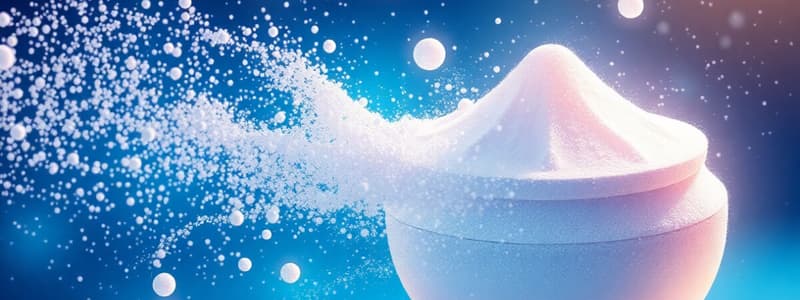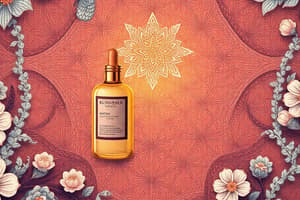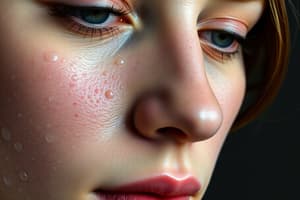Podcast
Questions and Answers
What is one of the primary actions of topical drugs?
What is one of the primary actions of topical drugs?
- To act at the surface of application (correct)
- To only provide superficial effects
- To be absorbed into systemic circulation
- To cause systemic toxicity
Topical compounds can only lead to beneficial effects.
Topical compounds can only lead to beneficial effects.
False (B)
Name one category of topical compounds based on their action.
Name one category of topical compounds based on their action.
Protective agents, antimicrobial, or astringent compounds
Talc is described as a very fine, white or grayish white, ________ powder.
Talc is described as a very fine, white or grayish white, ________ powder.
Which of the following properties is desirable for protective agents?
Which of the following properties is desirable for protective agents?
Match the following properties of talc with their descriptions:
Match the following properties of talc with their descriptions:
Talc can be absorbed in large amounts without any harmful effects.
Talc can be absorbed in large amounts without any harmful effects.
What is a benefit of using protectives in topical applications?
What is a benefit of using protectives in topical applications?
What is the main effect of the formation of a disulfide bridge in a sulfhydryl-containing protein?
What is the main effect of the formation of a disulfide bridge in a sulfhydryl-containing protein?
Halogenation reactions with hypochlorite are beneficial to the function of specific proteins.
Halogenation reactions with hypochlorite are beneficial to the function of specific proteins.
Which transition metal cations are known to interact with proteins as precipitating agents?
Which transition metal cations are known to interact with proteins as precipitating agents?
Hydrogen Peroxide Solution has a molecular weight of __________.
Hydrogen Peroxide Solution has a molecular weight of __________.
Match the following concepts with their descriptions:
Match the following concepts with their descriptions:
What causes Hydrogen Peroxide Solution to decompose rapidly?
What causes Hydrogen Peroxide Solution to decompose rapidly?
The interaction of metal ions with proteins is highly specific.
The interaction of metal ions with proteins is highly specific.
What is the primary role of the chlorine atom in the halogenation reaction with proteins?
What is the primary role of the chlorine atom in the halogenation reaction with proteins?
Hydrogen Peroxide is unstable when _____________ and may decompose suddenly when heated.
Hydrogen Peroxide is unstable when _____________ and may decompose suddenly when heated.
What happens to proteins when exposed to high concentrations of metal ions?
What happens to proteins when exposed to high concentrations of metal ions?
What is the primary action of silver ions on proteins?
What is the primary action of silver ions on proteins?
Silver nitrate's use as a topical agent does not cause any skin darkening.
Silver nitrate's use as a topical agent does not cause any skin darkening.
What is the condition termed when there is a deposition of free silver below the epidermis?
What is the condition termed when there is a deposition of free silver below the epidermis?
Silver ions can act as a potent __________ in ophthalmic solutions to prevent ophthalmia neonatorum.
Silver ions can act as a potent __________ in ophthalmic solutions to prevent ophthalmia neonatorum.
Match the following uses with their descriptions:
Match the following uses with their descriptions:
What is primarily responsible for the toxicity of iodine when ingested in large quantities?
What is primarily responsible for the toxicity of iodine when ingested in large quantities?
Iodine Tincture is less suitable for disinfecting wounds compared to Iodine Solution.
Iodine Tincture is less suitable for disinfecting wounds compared to Iodine Solution.
What treatment is usually administered to mitigate the effects of iodine toxicity?
What treatment is usually administered to mitigate the effects of iodine toxicity?
Povidone-Iodine is a complex of iodine with carrier ______ that acts as a solubilizing agent.
Povidone-Iodine is a complex of iodine with carrier ______ that acts as a solubilizing agent.
Match the following iodine preparations with their primary use:
Match the following iodine preparations with their primary use:
What is a major disadvantage of using Iodine Tincture on open tissue?
What is a major disadvantage of using Iodine Tincture on open tissue?
Silver Nitrate is only slightly soluble in water.
Silver Nitrate is only slightly soluble in water.
What colors do silver nitrate crystals develop when exposed to light and organic matter?
What colors do silver nitrate crystals develop when exposed to light and organic matter?
Solutions of silver nitrate in concentrations between ______ and ______% are used as antibacterial agents.
Solutions of silver nitrate in concentrations between ______ and ______% are used as antibacterial agents.
Match the following silver nitrate properties with their description:
Match the following silver nitrate properties with their description:
What is the primary purpose of calamine when applied to the skin?
What is the primary purpose of calamine when applied to the skin?
Calamine is obtained by heating zinc carbonate.
Calamine is obtained by heating zinc carbonate.
What is the chemical reaction for the thermal decomposition of zinc carbonate?
What is the chemical reaction for the thermal decomposition of zinc carbonate?
Calamine is used in dusting powders, ointments, and __________ for its soothing properties.
Calamine is used in dusting powders, ointments, and __________ for its soothing properties.
Which of the following terms describes a substance that kills microorganisms outright?
Which of the following terms describes a substance that kills microorganisms outright?
Match the terms with their definitions:
Match the terms with their definitions:
Which mechanism of action involves nonmetals and certain anions to exert oxidative action?
Which mechanism of action involves nonmetals and certain anions to exert oxidative action?
Disinfectants are safe for use on living tissues.
Disinfectants are safe for use on living tissues.
Name one common chemical used in the oxidation mechanism of inorganic antimicrobial agents.
Name one common chemical used in the oxidation mechanism of inorganic antimicrobial agents.
The term __________ refers to agents that do not kill microorganisms, but inhibit their growth.
The term __________ refers to agents that do not kill microorganisms, but inhibit their growth.
Flashcards
Topical Agents
Topical Agents
Compounds applied to the skin's surface, having localized effects, but potentially causing systemic absorption.
Protective Agents
Protective Agents
Insoluble, chemically inert compounds protecting skin from irritation, acting as adsorbents.
Talc
Talc
Hydrous magnesium silicate, a fine, white powder used as a protective agent due to its low adsorptive properties, unctuous nature, and lack of grittiness.
Calamine
Calamine
Signup and view all the flashcards
Antimicrobial Agents
Antimicrobial Agents
Signup and view all the flashcards
Antiseptics
Antiseptics
Signup and view all the flashcards
Germicides
Germicides
Signup and view all the flashcards
Disinfectants
Disinfectants
Signup and view all the flashcards
Astringents
Astringents
Signup and view all the flashcards
Mechanism of Action (Oxidation)
Mechanism of Action (Oxidation)
Signup and view all the flashcards
Mechanism of Action (Halogenation)
Mechanism of Action (Halogenation)
Signup and view all the flashcards
Mechanism of Action (Protein Precipitation)
Mechanism of Action (Protein Precipitation)
Signup and view all the flashcards
Hydrogen Peroxide (H₂O₂)
Hydrogen Peroxide (H₂O₂)
Signup and view all the flashcards
Iodine
Iodine
Signup and view all the flashcards
Povidone-iodine
Povidone-iodine
Signup and view all the flashcards
Silver Nitrate (AgNO₃)
Silver Nitrate (AgNO₃)
Signup and view all the flashcards
Study Notes
Topical Agents
- Topical compounds are applied to the surface of the body.
- They have a localized effect, but can be absorbed and cause systemic effects.
- They are categorized into protective agents, antimicrobial agents, and astringent agents.
Protective Agents
- Protectives are insoluble and chemically inert.
- They protect the skin from mechanical irritation.
- They act as adsorbents, absorbing moisture and reducing friction.
- They are typically used as powders, ointments, or suspensions.
Talc
- Talc is a hydrous magnesium silicate.
- It is a very fine, white or grayish white, crystalline powder.
- It is unctuous, adheres readily to the skin, and is free from grittiness.
- It is odorless, tasteless, and insoluble in water, dilute acids, and dilute bases.
- It has very low adsorptive properties.
Calamine
- Calamine is a topical protective.
- It is obtained by calcining zinc carbonate.
- It is used in dusting powders, ointments, and lotions for its soothing, adsorbent, and protective properties.
Antimicrobial Agents
- Antimicrobial agents prevent and reduce infections caused by microorganisms.
- Antiseptics kill or inhibit the growth of microorganisms on living tissues.
- Germicides kill microorganisms outright.
- -stat agents (e.g., bacteriostat) inhibit the growth of microorganisms.
- Disinfectants kill microorganisms on inanimate objects.
- Sterilization completely removes or kills all microorganisms.
Mechanisms of Action of Inorganic Antimicrobial Agents
- Oxidation: Compounds like hydrogen peroxide, permanganates, and halogens oxidize proteins.
- Halogenation: Hypohalite and hypochlorite antiseptics react with protein molecules, altering their conformation.
- Protein Precipitation: Metallic ions with high charge/radius ratios or strong electrostatic fields precipitate proteins, affecting their function.
Hydrogen Peroxide (H₂O₂)
- Hydrogen Peroxide solution is a clear, colorless liquid.
- It is unstable and deteriorates upon standing or agitation.
- It decomposes when in contact with oxidizing or reducing substances.
- It is used as an antiseptic.
Iodine
- Iodine is a very active element.
- It is easily inactivated by organic materials in the gastrointestinal tract.
- Ingestion of large quantities can cause corrosive action on the gastrointestinal tract.
- Iodine solutions are used as topical antiseptics (Iodine Tincture and Iodine Solution) and to disinfect drinking water.
Povidone-iodine
- Povidone-iodine is an iodophor, a complex of iodine with a carrier organic molecule.
- It slowly releases iodine in solution.
- It is used as a topical antiseptic because it is less irritating than iodine tinctures.
Silver Nitrate (AgNO₃)
- Silver Nitrate is a colorless or white crystal that becomes gray or grayish black when exposed to light.
- It is very soluble in water.
- Solutions of silver nitrate (0.5-1.0%) are used as antibacterial agents.
- Silver ions precipitate both bacterial and human proteins, leading to antibacterial, astringent, irritant, and corrosive effects.
- Prolonged use can cause argyria, a darkening of the skin due to silver deposition.
- It is used as an antibacterial, prophylactic measure against ophthalmia neonatorum, and in burn treatment.
Astringents
- Astringents precipitate proteins on the surface of cells, causing coagulation and tissue constriction.
- They have limited penetration and do not cause the death of cells.
- They are used as styptics (stop bleeding), antiperspirants, and to constrict mucous membranes.
Studying That Suits You
Use AI to generate personalized quizzes and flashcards to suit your learning preferences.




